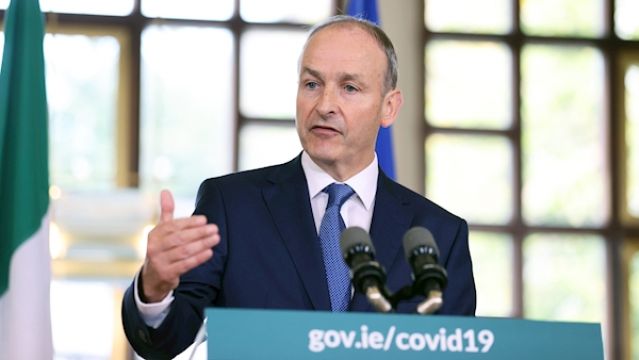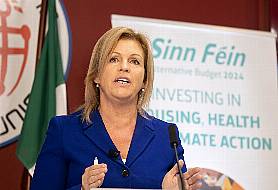The Government has announced Ireland’s new medium-term plan for dealing with coronavirus, Living with Covid-19, which will come into effect at midnight, Tuesday 15th.
Taoiseach Micheál Martin has announced a new approach will be taken to manage the virus, including additional restrictions in Dublin. Keeping schools and childcare facilities open was also identified as a "top priority" of the plan.
Speaking at a press briefing, he introduced the new framework, with five levels of response, with every county currently at level two.
Level two will mean that current restrictions will remain in place until October 4th. Level one represents the lowest level of restrictions, while level five is a situation of complete lockdown.
Despite increased levels of the virus, Dublin has been given the same status as the rest of the country. However additional restrictions will be placed on home visits, indoor gatherings and care home visits in the capital, as well as wet pubs remaining closed.
People in Dublin have been encouraged not to leave the county and if they do, they are being told to to limit their interactions to one household. Visits to households should also be limited to people from one household in the capital.
Despite Ministers expressing serious concern over a dramatic increase in cases in Dublin in recent weeks, the Cabinet decided against moving Dublin to Level 3, instead tailoring the extra conditions for the capital without changing the level.
"Current Covid numbers in Dublin are very worrying and the Government today has decided to introduce additional measures [for Dublin],” said Mr Martin.
Mr Martin said that the decision to give Dublin a '2.5 level' was due to advice from the National Public Health Emergency Team (NPHET), which was issued last week when the new framework was already being formulated.
Elsewhere in the country, household visits of up to six people from up to three homes will continue to be permitted, and outside the household setting, groups of six people indoors, and 15 people outdoors from up to three homes will be allowed.
Mr Martin also announced that the Winter Plan Budget would be worth €600 million to the healthcare sector, a eight-fold increase on last winter. Commenting on the plan, Minister for Health Stephen Donnelly said it has been "designed along Sláintecare guideline plans".
Tánasite Leo Varadkar confirmed that Pandemic Unemployment Payment will not be closed to new entrants, or those made unemployed for second time due to the pandemic, as was previously planned.
Mr Varadkar reiterated that wet pubs in 25 counties, excluding Dublin, will reopen on September 21st.
Indoor gatherings will be permitted to have 50 people in attendance, while 100 people will be permitted at outdoor events. In addition, 200 people will be permitted to attend events in large outdoor stadia, which have a minimum capacity of 5,000.
The possibility of more spectators being permitted to attend games in venues such as Croke Park and the Aviva is also being considered.
Mr Martin highlighted that the limit on crowds at sporting events was made following advice from public health experts and that spectators must ensure they uphold public health guidance "going to and from the venue and keeping your distance at the venue".
He also announced the establishment of a new Covid-19 oversight group, which will aid the coordination of department approaches.
Ireland will also adopt a traffic-light system for international travel, saying the a European-wide model proposed by the European Commission will be broadly supported, adding that countries with a 14-day incidence rate of 25 cases or less per 100,000 people will be included on the "Normal Precautions" (green) list.
Ireland's 14-day incidence rate is currently 48.5 according to the most recent data from the European Centre for Disease Prevention and Control (ECDC).
According to the same data from the ECDC, which monitors incidence rates in EU and EEA counties and the UK, there are 10 countries in that area with an incidence rate of 25 or below: Germany, Sweden, Poland, Finland, Lithuania, Estonia, Iceland, Cyprus, Latvia and Liechtenstein.
Under the EU travel plan, the Government will drop the 14-day period of quarantine for non “green list” countries and instead adopt a system of testing at airports and ports for incoming passengers.
Commenting on the new approach, Mr Martin said: “This is a plan which gives clarity of each of our responsibilities. It includes concrete measures and shows how we can limit impact of the virus while keeping schools open and protecting and expanding employment.
“The plan is broad and comprehensive. Protecting public health remains an absolute priority."
The full outline of current guidelines can be viewed here.
Reaction
The plan has faced criticism in the Dáil with Labour Party leader Alan Kelly saying that Dublin has been given a "yellow card" by being placed in level two despite additional restrictions being deemed necessary.
"We cannot have a situation where we have Dublin at two and a bit, that they sort of get a yellow card, but if they behave themselves in a short space of time they may do back to where all the rest of us are.
"It's like something Orwellian, some of us are more equal than others. If you say that to the people in Laois, Offaly or Kildare, they won't agree with you."
Sinn Féin leader Mary Lou McDonald also criticised the Government's plan, saying "today you promised clarity, but instead what we have had is further confusion".
Ms McDonald also commented on the test and trace system, saying it needed to be improved in order to get the virus under control.
@MaryLouMcDonald challenges government failure on testing and tracing
"People are frustrated with your inability to see the most basic thing - get testing and tracing right and all else will follow" #covid19 pic.twitter.com/9lLFPaZrB7— Sinn Féin (@sinnfeinireland) September 15, 2020
Social Democrats joint leader Roisin Shortall branded the plan “confusing”.
“The new plan was supposed to provide clarity about the five levels of risk, yet on the first day of the announcement the Government decides to muddy the waters and to talk about a ‘two-and-a-bit’ level,” she said.
Ms Shortall added: “How can you blame people for being confused about what you’re saying – it is entirely confusing.”
She also questioned if it was appropriate to deal with an area the size of county Dublin as one homogeneous area, highlighting that there were varying rates of virus prevalence in different parts.







